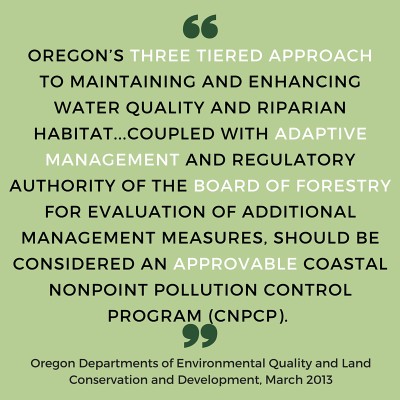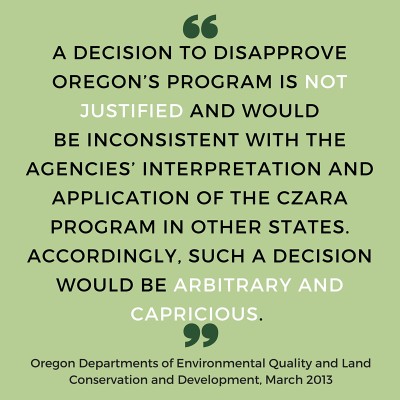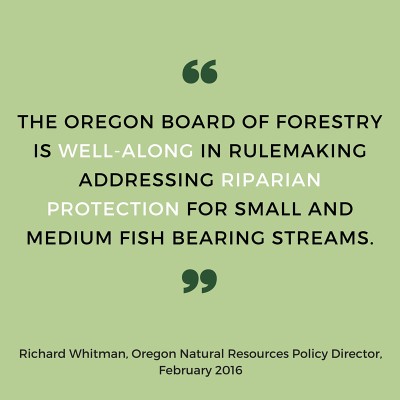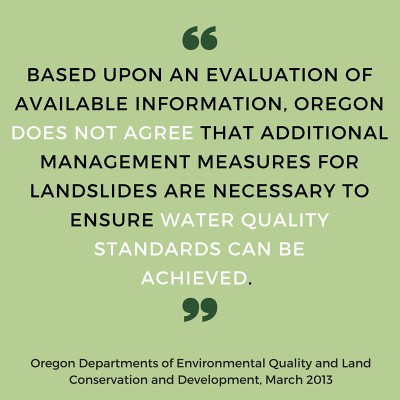News & Information to Know and Share
Keep up on the latest information about Oregon’s working forests
Featured View

Refuting the CZARA Disapproval
 On March 9, the Environmental Protection Agency (EPA) and the National Oceanic and Atmospheric Administration (NOAA), Oregon’s Natural Resources Policy Director, sent a letter to Richard Whitman formally announcing that the agencies will not release the withheld portion of the 2015 grant funding ($1.2 million) intended for coastal communities and water quality improvement and nonpoint source pollution projects, and that they will continue to withhold funds until Oregon’s coastal nonpoint pollution control program under the Coastal Zone Act Reauthorization Amendments (CZARA) is approved. This makes Oregon the only state of 33 to be disapproved for funding in spite of the fact that Oregon has some of the strictest forest protection laws in the country and the Board of Forestry is currently in rulemaking to expand riparian protection for small and medium fish-bearing streams in western Oregon.
On March 9, the Environmental Protection Agency (EPA) and the National Oceanic and Atmospheric Administration (NOAA), Oregon’s Natural Resources Policy Director, sent a letter to Richard Whitman formally announcing that the agencies will not release the withheld portion of the 2015 grant funding ($1.2 million) intended for coastal communities and water quality improvement and nonpoint source pollution projects, and that they will continue to withhold funds until Oregon’s coastal nonpoint pollution control program under the Coastal Zone Act Reauthorization Amendments (CZARA) is approved. This makes Oregon the only state of 33 to be disapproved for funding in spite of the fact that Oregon has some of the strictest forest protection laws in the country and the Board of Forestry is currently in rulemaking to expand riparian protection for small and medium fish-bearing streams in western Oregon.
The coastal nonpoint pollution control program was established in 1990 and is jointly administered by NOAA and EPA. The program is designed to help protect and restore coastal waters in coastal states and territories by assisting states in establishing management programs that protect such waters from nonpoint source pollution. Once a state has an approved program, the federal agencies distribute grant funding to support implementation of that program.
In 1998 Oregon was granted conditional approval, a status initially given to all 33 states and territories that have submitted coastal nonpoint pollution control programs. Conditional approvals are intended primarily to provide states and territories additional time to address issues NOAA and the EPA identify as needing further progress before they will fully approve the program. Today, nearly one-third of those states continue to have conditional approvals, many of which have considerably less restrictive forest management laws than Oregon.
In 2009, the Northwest Environmental Advocates, an environmental group based in Portland and led by Nina Bell, filed the only lawsuit in the country against the EPA and NOAA over the conditional status of a state’s program. As a result of the settlement agreement from that case, the EPA and NOAA agreed to either approve or disapprove Oregon’s program.
 In January 2015, the EPA and NOAA formally disapproved Oregon’s coastal nonpoint pollution control program. The agencies pointed exclusively to forestry, focusing on protection of non-fish bearing streams, management of forest roads, landslides, and the application of herbicides around streams. Interestingly, the agencies gave a pass to onsite sewage disposal systems for implementing voluntary measures (something they are unwilling to accept in the context of forestry) and chose not to address “concerns with the State’s agriculture program.”
In January 2015, the EPA and NOAA formally disapproved Oregon’s coastal nonpoint pollution control program. The agencies pointed exclusively to forestry, focusing on protection of non-fish bearing streams, management of forest roads, landslides, and the application of herbicides around streams. Interestingly, the agencies gave a pass to onsite sewage disposal systems for implementing voluntary measures (something they are unwilling to accept in the context of forestry) and chose not to address “concerns with the State’s agriculture program.”
While the disapproval was supposed to trigger an immediate one-third decrease in nonpoint source grant funding, Oregon continued to negotiate with the agencies in an effort to secure the 2015 funding, emphasizing Oregon’s strict forest protection laws which are based in science and adaptive to growing scientific knowledge. In February 2016, Richard Whitman sent a short letter to the agencies indicating, again, that Oregon believes its program is fully approvable. With remarkable efficiency for federal agencies, the EPA and NOAA replied jointly on March 9, 2016 that they would not release the withheld portion of the 2015 funding.
The position of the federal agencies is perplexing. Their objective seems to be the implementation of prescriptive regulations rather than achieving positive environmental outcomes based on rigorous science. Oregon has a sound and thorough defense of its regulation and outcomes around all issues raised by the EPA and NOAA – a defense that is backed by extensive research and monitoring. To this end, Oregon is already addressing the issues raised by the federal agencies:
Riparian protection: The Oregon Forest Practices Act (FPA) is adaptive and rules have been modified with the inp ut of research. Over the years, the FPA has been changed to require the retention of trees and vegetation during harvest which must be left along fish streams as a buffer for shade and large wood recruitment. Last November, the Board of Forestry voted to adopt new steam protection rules and is currently in rulemaking to expand riparian protection for small and medium streams in western Oregon where salmon, steelhead, or bull trout are present. Oregon has also conducted three separate paired watershed studies to measure the harvest effect on conditions in streams that have shown no measureable downstream effect on stream temperatures.
ut of research. Over the years, the FPA has been changed to require the retention of trees and vegetation during harvest which must be left along fish streams as a buffer for shade and large wood recruitment. Last November, the Board of Forestry voted to adopt new steam protection rules and is currently in rulemaking to expand riparian protection for small and medium streams in western Oregon where salmon, steelhead, or bull trout are present. Oregon has also conducted three separate paired watershed studies to measure the harvest effect on conditions in streams that have shown no measureable downstream effect on stream temperatures.
Legacy forest roads: Oregon’s forest practice rules are some of the most rigorous in the nation. From new road construction, to maintenance, to water diversions, to culvert placement, to road upgrades; the Oregon FPA is a rigorous body of laws that ensure forest roads are not compromising water quality. Additionally, landowners, through The Oregon Plan, have spent over $96 million through 2011 making improvements to outdated culverts and stream-side care to help protect water quality and improve fish habitat. Many of these improvements divert water from road surfaces and protect roads from degradation.
Landslide-prone areas: The state has extensive research in western Oregon as it applies to age of tree stands, slope steepness, soil density and other factors. Upon its review of existing information and additional research, the state found that the federal agencies’  concerns were unfounded. The FPA already dictates a rigorous process for both screening areas of potential instability and adding protective measures in areas that are deemed as having higher landslide risk.
concerns were unfounded. The FPA already dictates a rigorous process for both screening areas of potential instability and adding protective measures in areas that are deemed as having higher landslide risk.
Aerial application of pesticides: Oregon relies on regulations set by the Oregon Department of Agriculture and U.S. Environmental Protection Agency for protection of streams during pesticide applications. In addition to the strength of the herbicide regulations is the fact that no scientific evidence exists that applications impair water quality. In fact, just the opposite is true. According to the Oregon Water Quality Index, forestland sites have the highest water quality of all sites statewide, including range, agricultural and urban areas. And every extensive study of western watersheds conducted by state or municipal agencies has found no evidence that herbicides exist at a level harmful to public health. Applying more prescriptive buffers is simply a solution in search of a problem.
The federal agencies are in error, and their continued focus on forestry is puzzling. Through all of this, they have failed to produce any evidence that Oregon forest practices are actually contributing to exceedances of water quality standards. It’s akin to focusing the bulk of our law enforcement resources in our lowest crime neighborhoods. Surely, there are better ways to allocate precious resources. The state shouldn’t throw away the foundation of its forest management for the minimal grant funding federal agencies are offering. Science is at the center of Oregon’s forest management; it is the foundation of policies that protect our water and wildlife, while providing for the sustainable use of natural resources.
Trending

News
In Oregon, homes don’t come from the hardware store
**This opinion originally ran in the Portland Tribune It’s rare to see Democrats and Republicans come together as productively as they recently did with the passage of a $376 million package aimed at addressing Oregon’s chronic undersupply of housing. Despite divisive national rhetoric, Oregon l...
Read More »

Our Views
Oregon Forests Capture Half of Our State’s Human-Caused Carbon Emissions | Forests and Carbon
Imagine you’re a university professor who just finished writing a research paper claiming timber harvest is the leading source of carbon emission in Oregon. You print off your final paper copy, seal up the paper journal submission envelope, and put the envelope in the mail so it can make its way t...
Read More »
